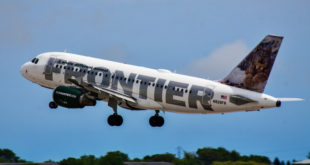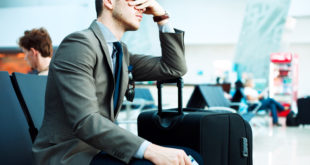Boarding Processes–where are they now and can they get better?
 Yesterday, as Keri, my husband, and I fought to try to get through other people to board during our boarding group, I couldn’t help but notice the Southwest flight boarding next to us.
Yesterday, as Keri, my husband, and I fought to try to get through other people to board during our boarding group, I couldn’t help but notice the Southwest flight boarding next to us.
They were lined up nicely and boarded the plan in an organized manner. When people check-in, they not only get a boarding group, but also a specific spot in line. This certainly beats the Southwest Process I remember from my 22nd Birthday. I went to San Antonio and spent the majority of my birthday sitting in the front of the C-line with my friends, hoping we’d get to sit together (we did!). I also spent most my birthday unexpectedly in Houston Hobby, but that’s a story for another day.
 US Airways’ Blue (Priority) and Red (General) lines are a huge improvement over the way it was before–one lane only. But having two lines gives people an incentive to line up in their respective lines, even if they aren’t in the first boarding group.
US Airways’ Blue (Priority) and Red (General) lines are a huge improvement over the way it was before–one lane only. But having two lines gives people an incentive to line up in their respective lines, even if they aren’t in the first boarding group.
I’ve seen disabled passengers try to fight their way through the crowd to get on the plane. I was also trying to board once when a woman refused to move herself and her baggage out from the front of the boarding lane. She kept muttering, “I’m zone 2!” over and over in response to the gate agent’s request that she let people on. She stuck to her guns, and the people already lined up in General Boarding were nice enough to let everyone pass.
United is lining people up in five separate lines by zone number, which is a huge improvement over US Airways.
But is there a better way?
There are a lot of theories about what works best with boarding. Back to front, those without carry-ons first, Window/Middle/Aisle, and back-to-front-but-every-other-row-at-a-time.
Believe it or not, random boarding is more efficient than back-to-front boarding. Don’t believe me? Check out these cool simulations.
Even though all people boarding towards the back of the plane will be headed there in back-to-front boarding, one person can still hold everyone else up. Also, as soon as someone needs to get up from an aisle to let a middle seat in–and then both get up to let the window in, the whole efficiency equation falls apart.
A random version of window-middle-aisle seemed the best when run through the simulations. But we are also looking at airline boarding as is. Luckily, there have been some recent innovations that could change boarding for the better.
The Future
Stuck behind someone? Slide a seat out of the way and walk around them.
Harriet Baskas for CNBC reported today on the Side-Slip seats--ones that could be pushed out of the way if needed.
According to the article:
“I thought the process would go faster if I could just walk around them.”
Here’s a photo of the device from the official Side-Slip website:
As the plane fills up, it will become less useful–but it should definitely make early stages of boarding much better.
Baskas also reports that Alaska Airlines is trying out boarding from both sides of the plane using a ramp:
US Airways has been deplaning its shuttle planes from both sides to save time. I’ve noticed a certain degree of unsureness from the customers on the planes I’ve been on, and some in the back push their way to the front.
It’s clear from the effort airlines are putting into this that boarding delays are much more costly than just customer annoyance.
As for me, boarding is the #1 most stressful part of flying for me. Not delays, not mis-connections. I just feel so anxious waiting and not knowing how many people I may have to fight through.
I want to suggest a pilot program. If you let me board a plane early and skip that process, I will help you turn around the plane. I am not kidding. I will.
What improvements would you like to see to the boarding process?
Disclaimer: I am serious. Are you listening, US Airways?  I’ll keep my phone on.
 Le Chic Geek
Le Chic Geek





Hi Jeanne,
I am the inventor of the Side-Slip Seat. Thanks for the nice comments. We are steadily getting to a place where this seat will be on airlines. We originally designed it to get off the plane faster. Since then we have realized a lot of extra advantages to a wider aisle (and 3 inch wider middle seat) such as fuel savings (less ground power, more air time) which allows a fleet reduction, which in turn reduces airport delays on the taxiways. A wider middle seat…well who wouldn’t want any advantage for being stuck in the middle seat. But my favorite is the wheel chair access, no more sky chairs,…full size wheelchairs all the way to your seat.
Anyway thanks for the publicity, we will get there, and hopefully everyone will be happier and less stressed.
Cheers
Hank